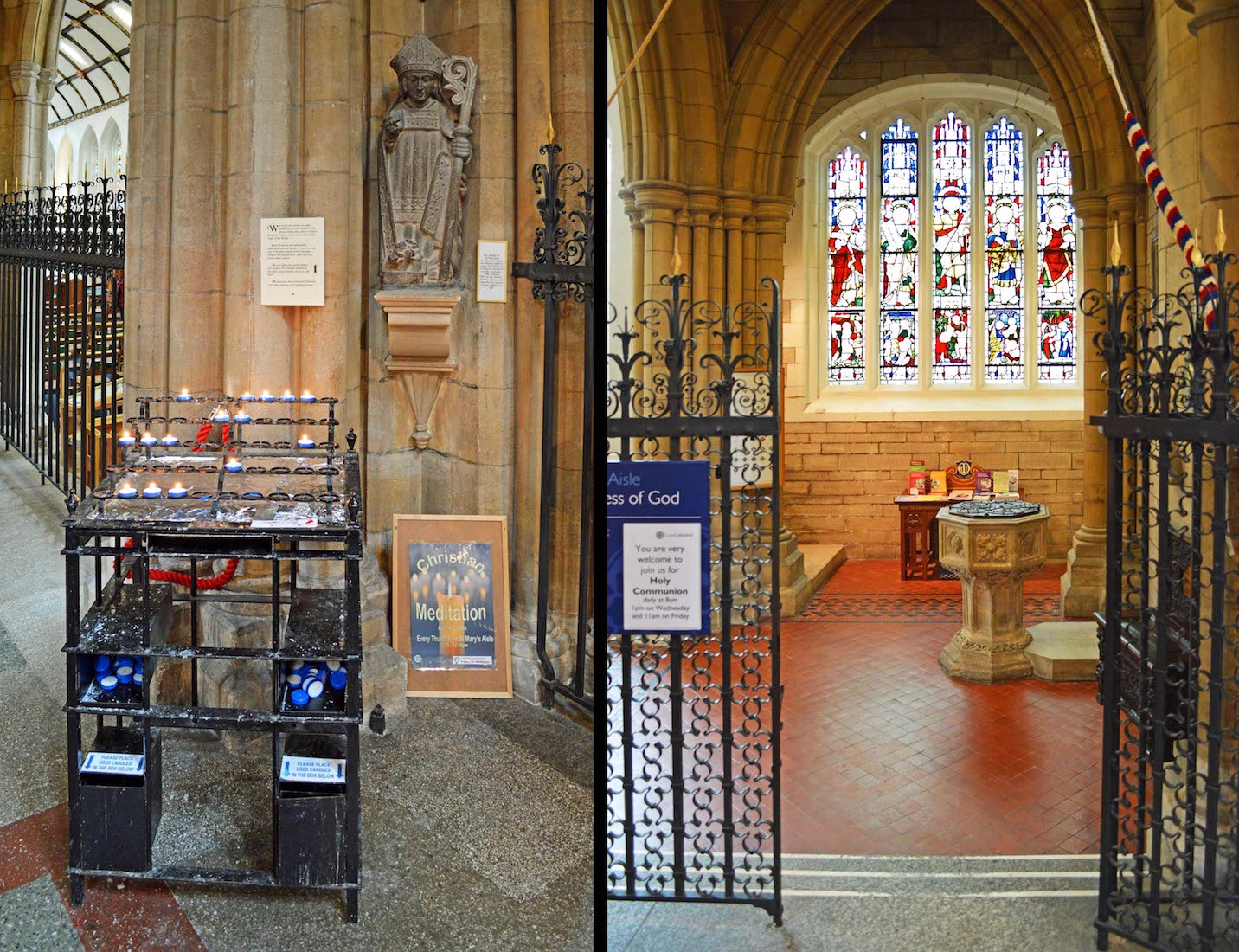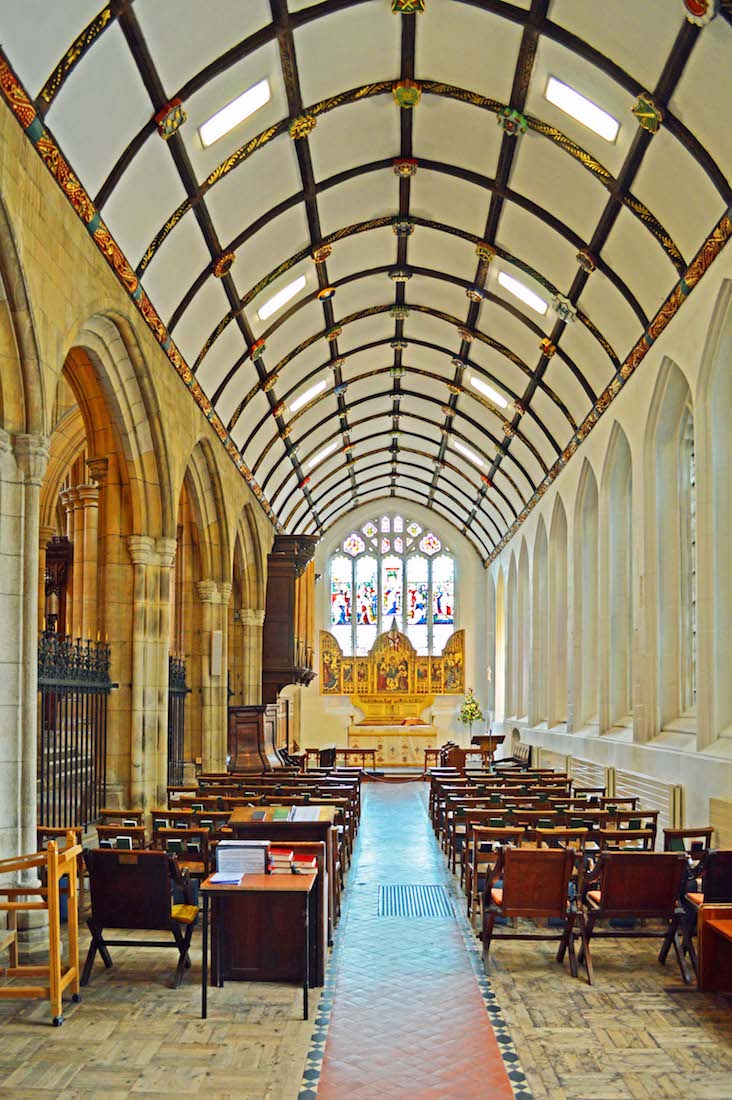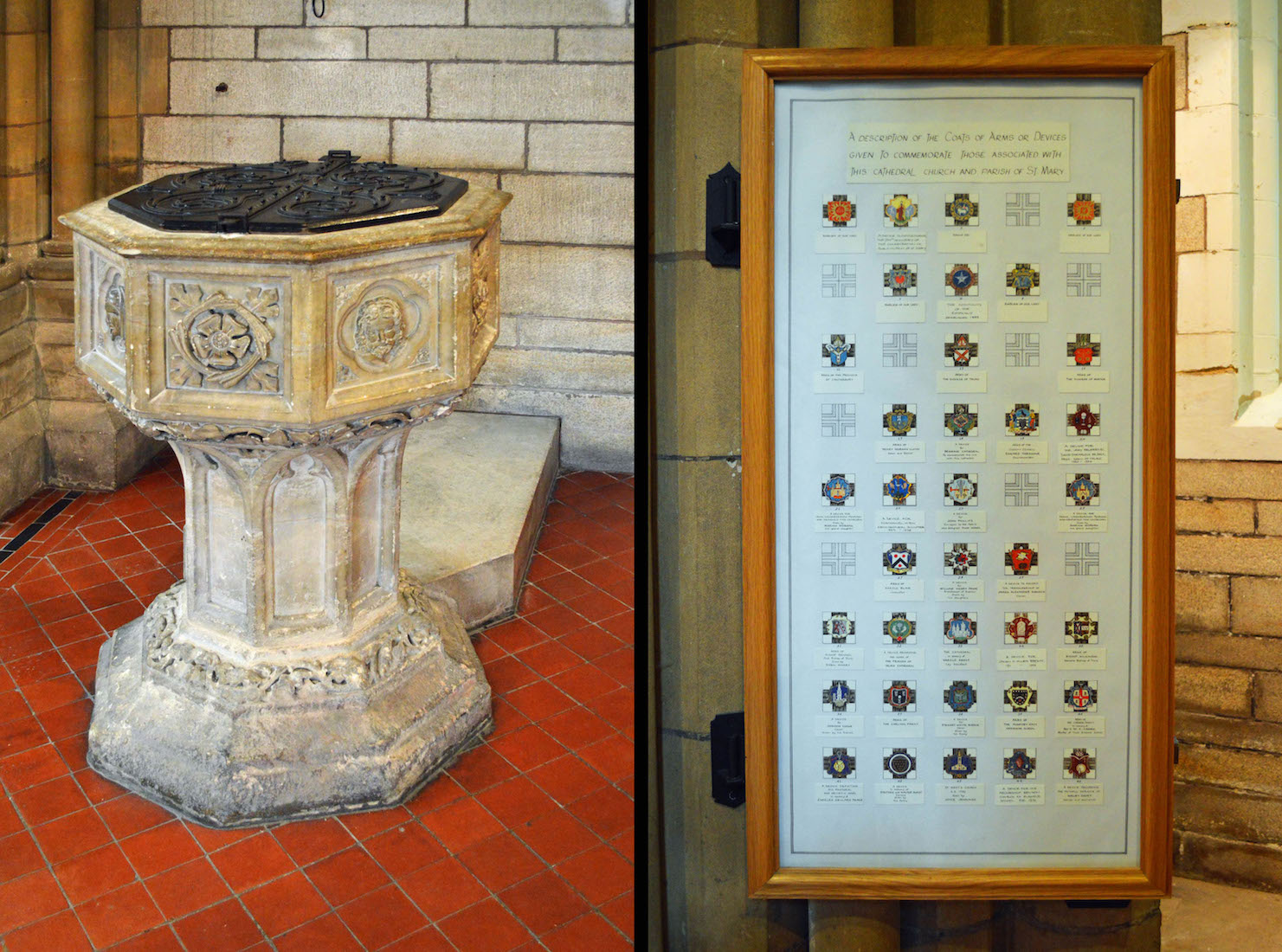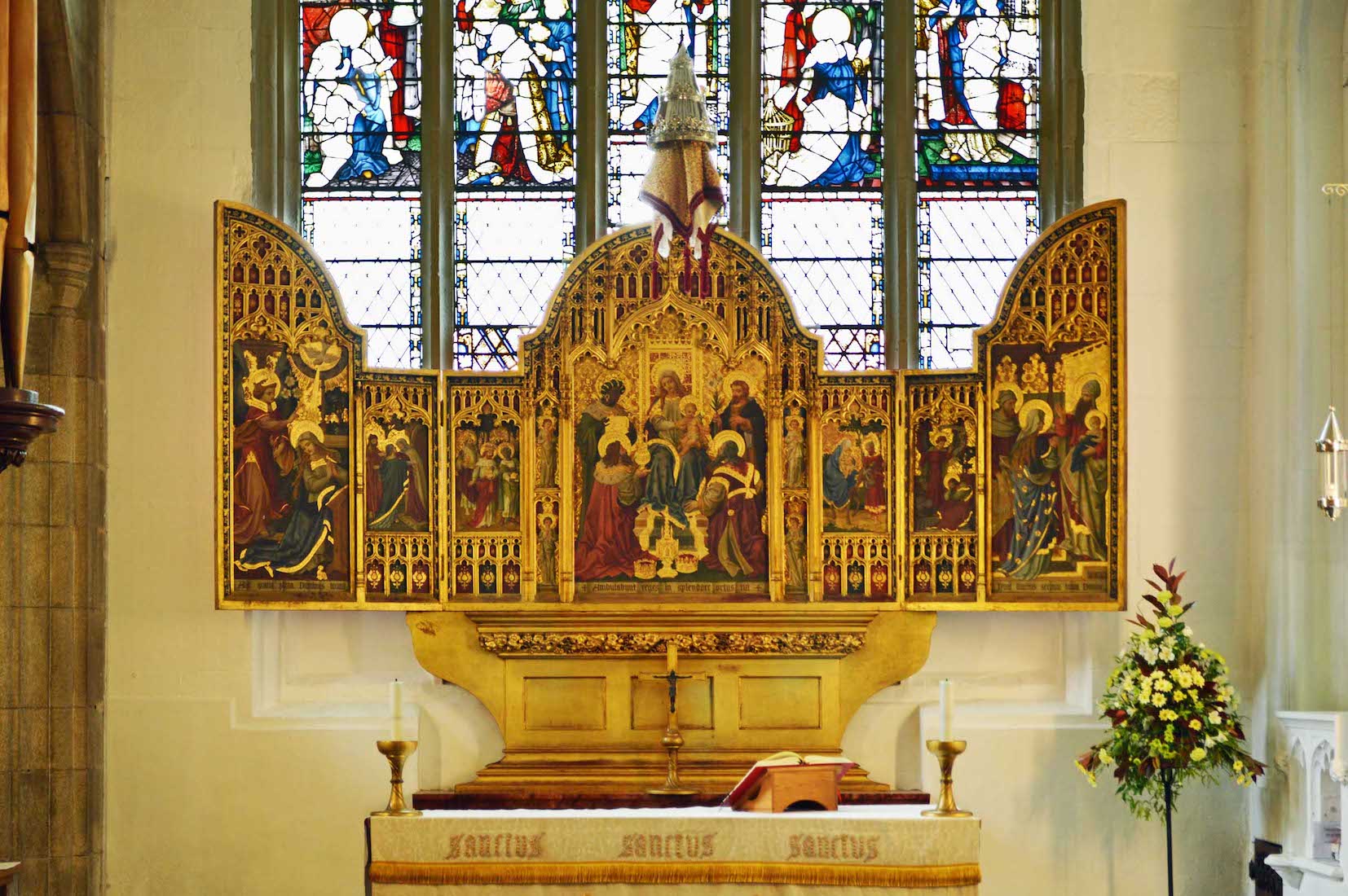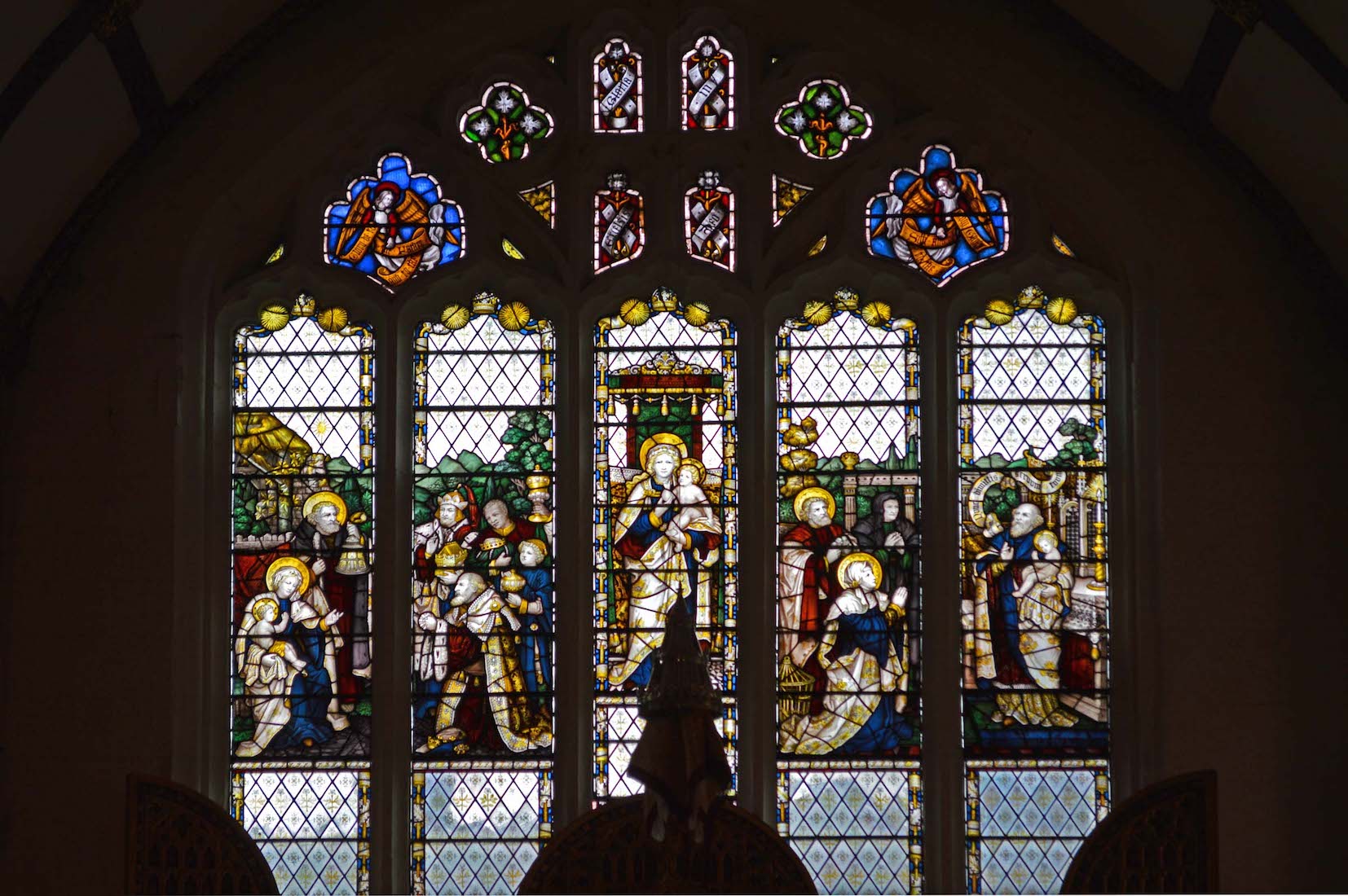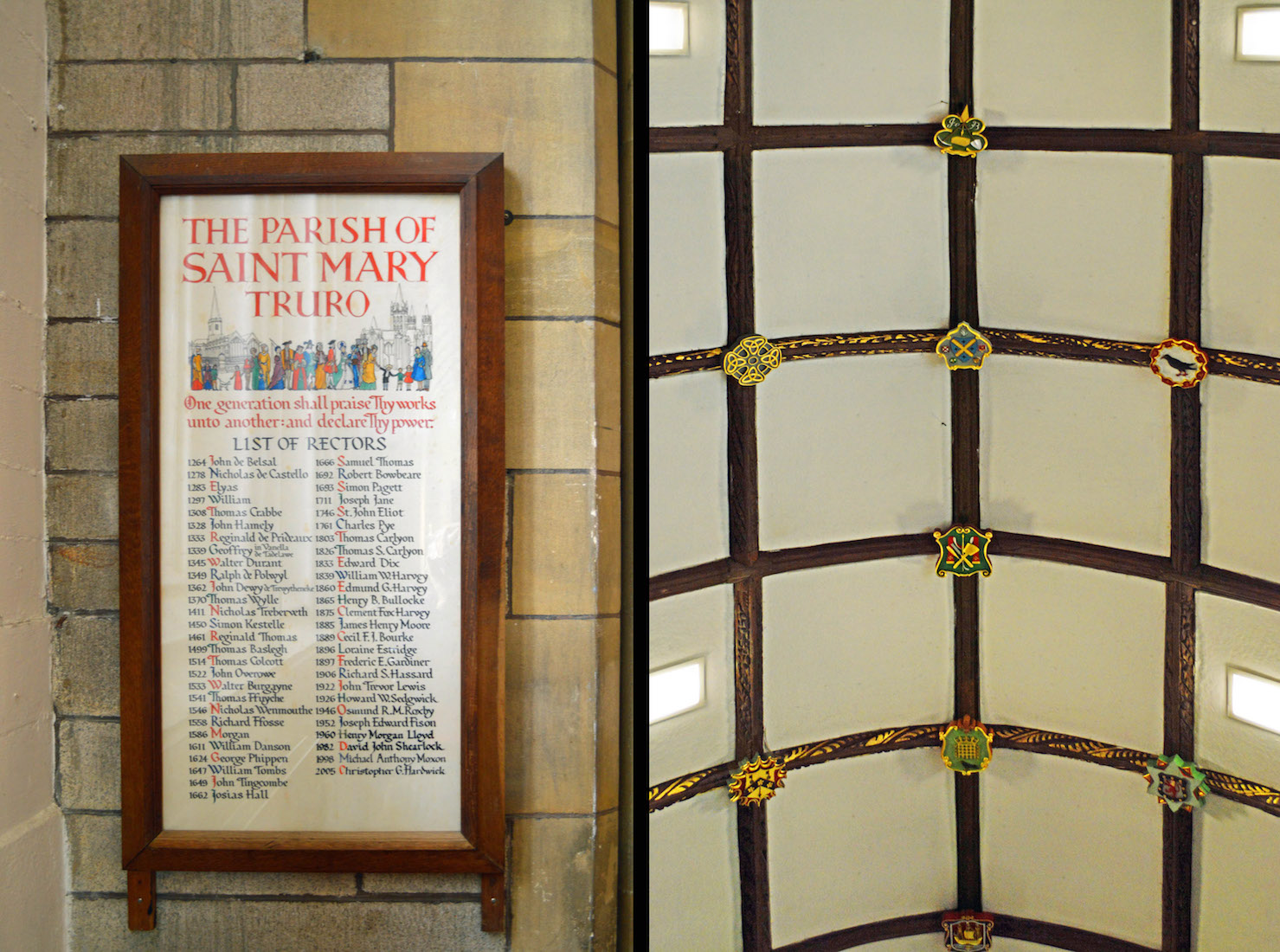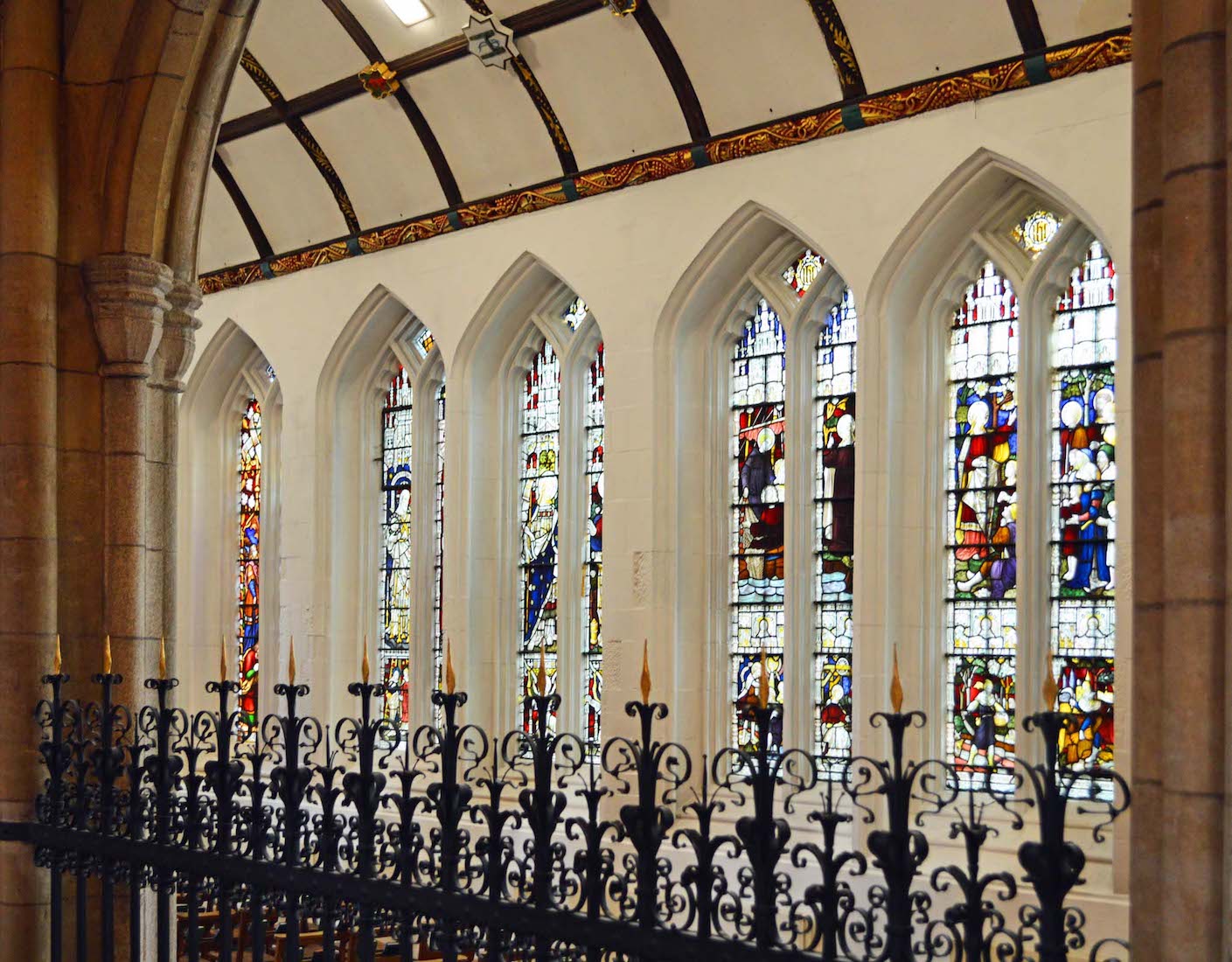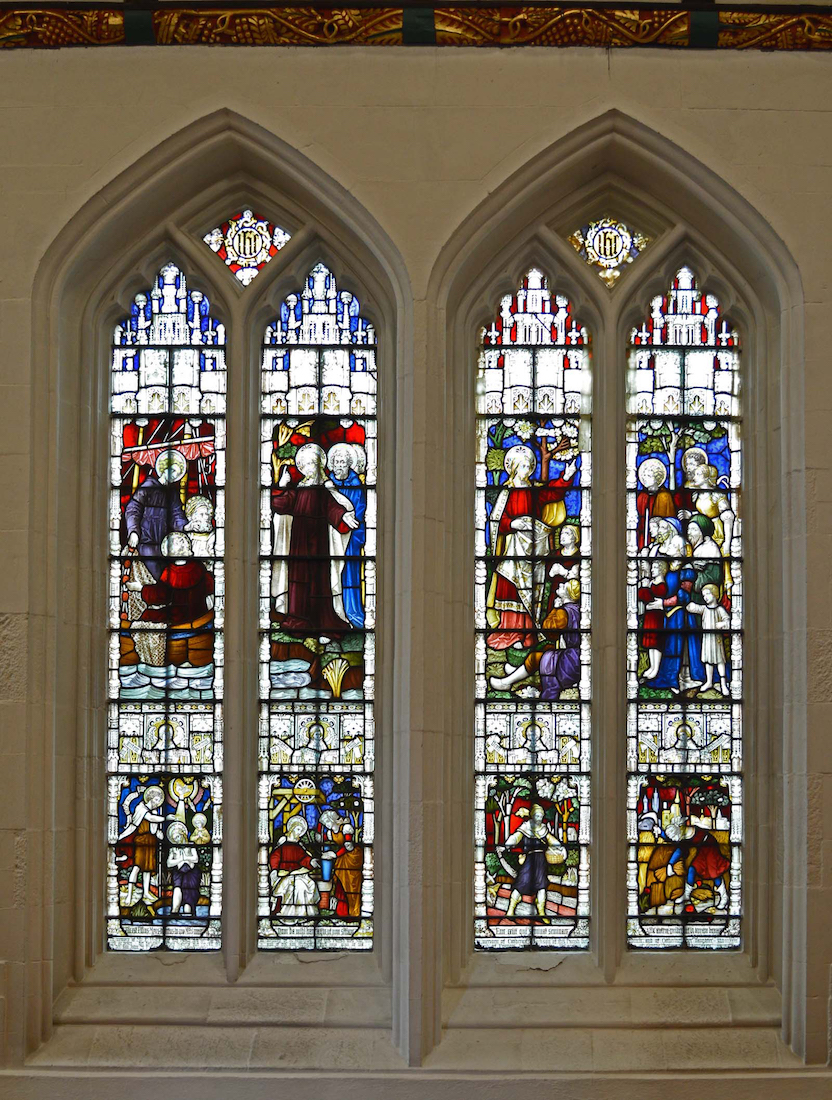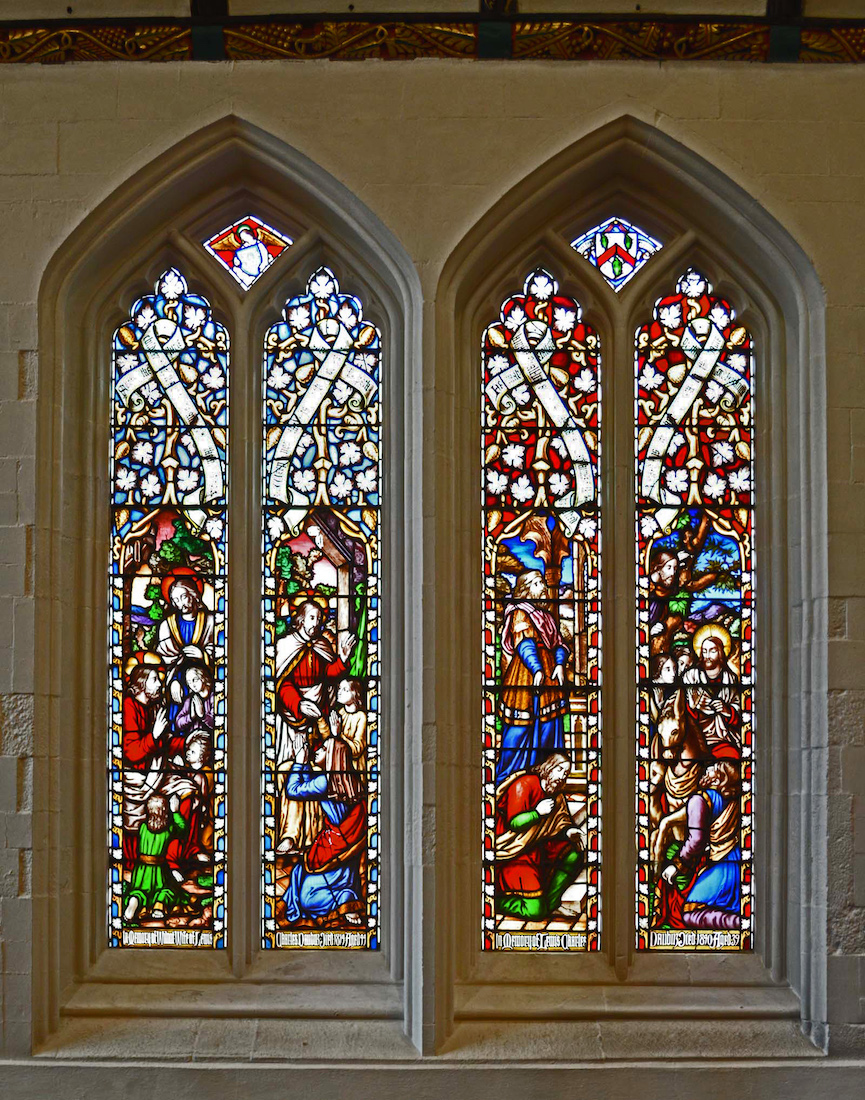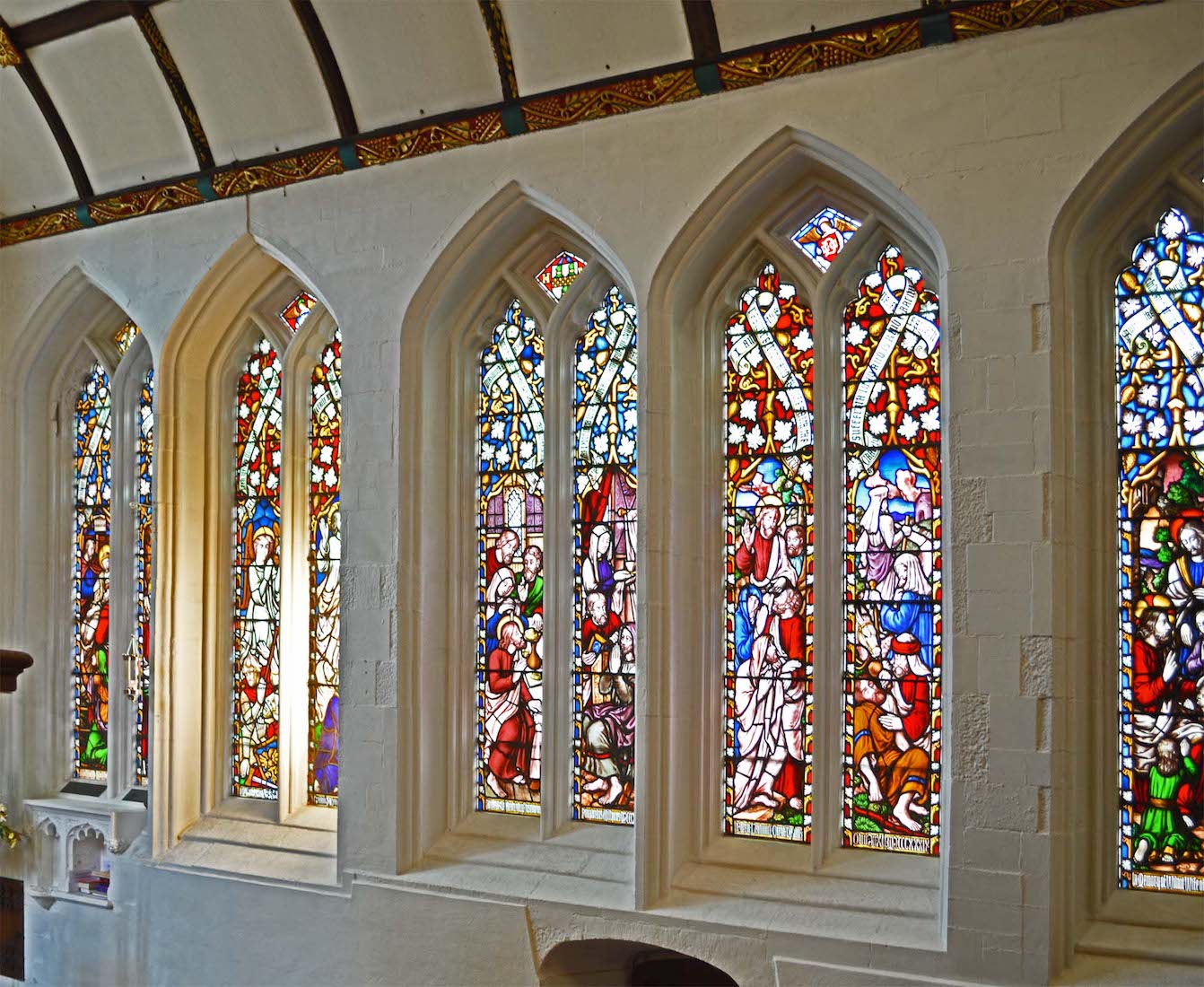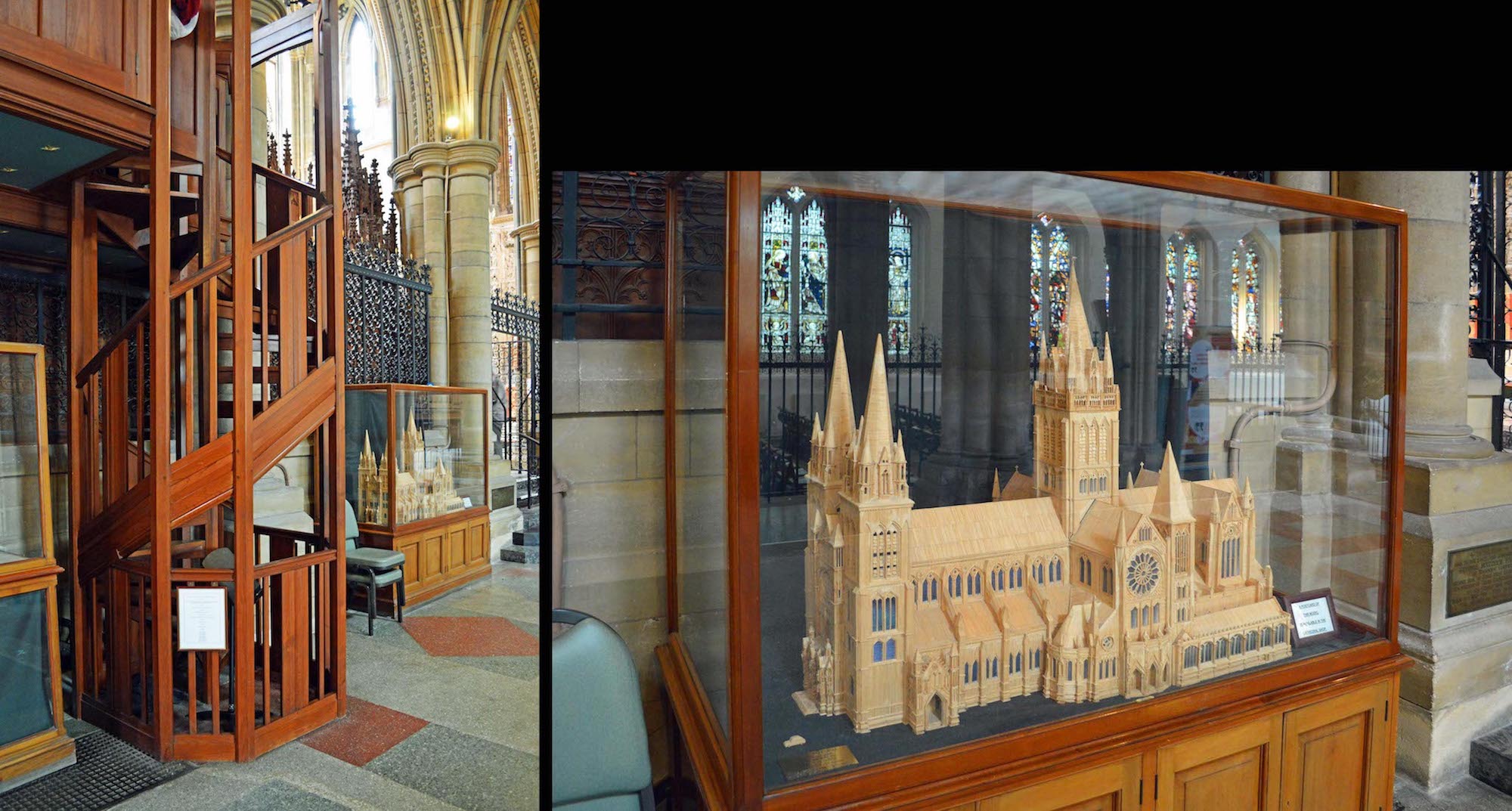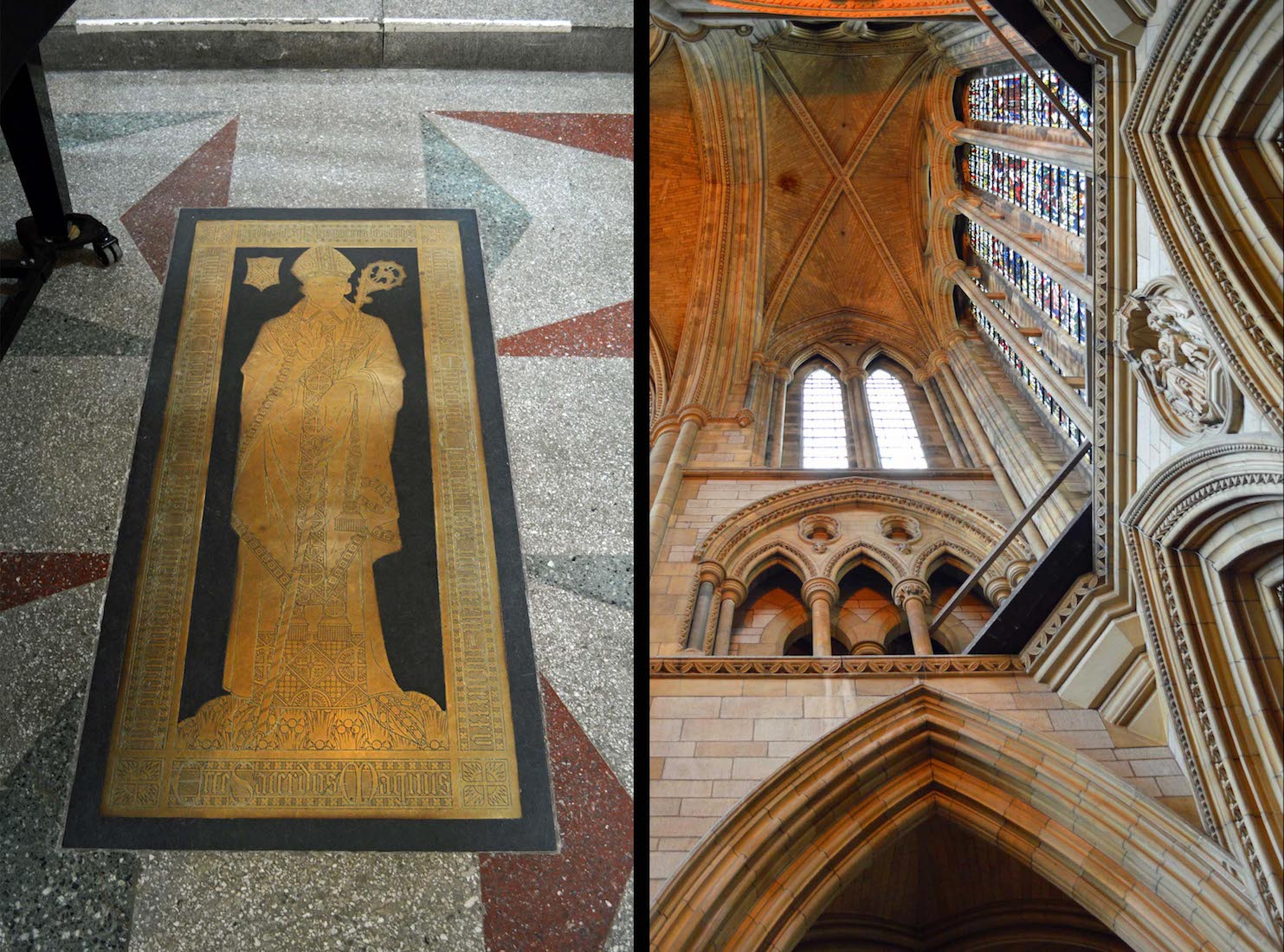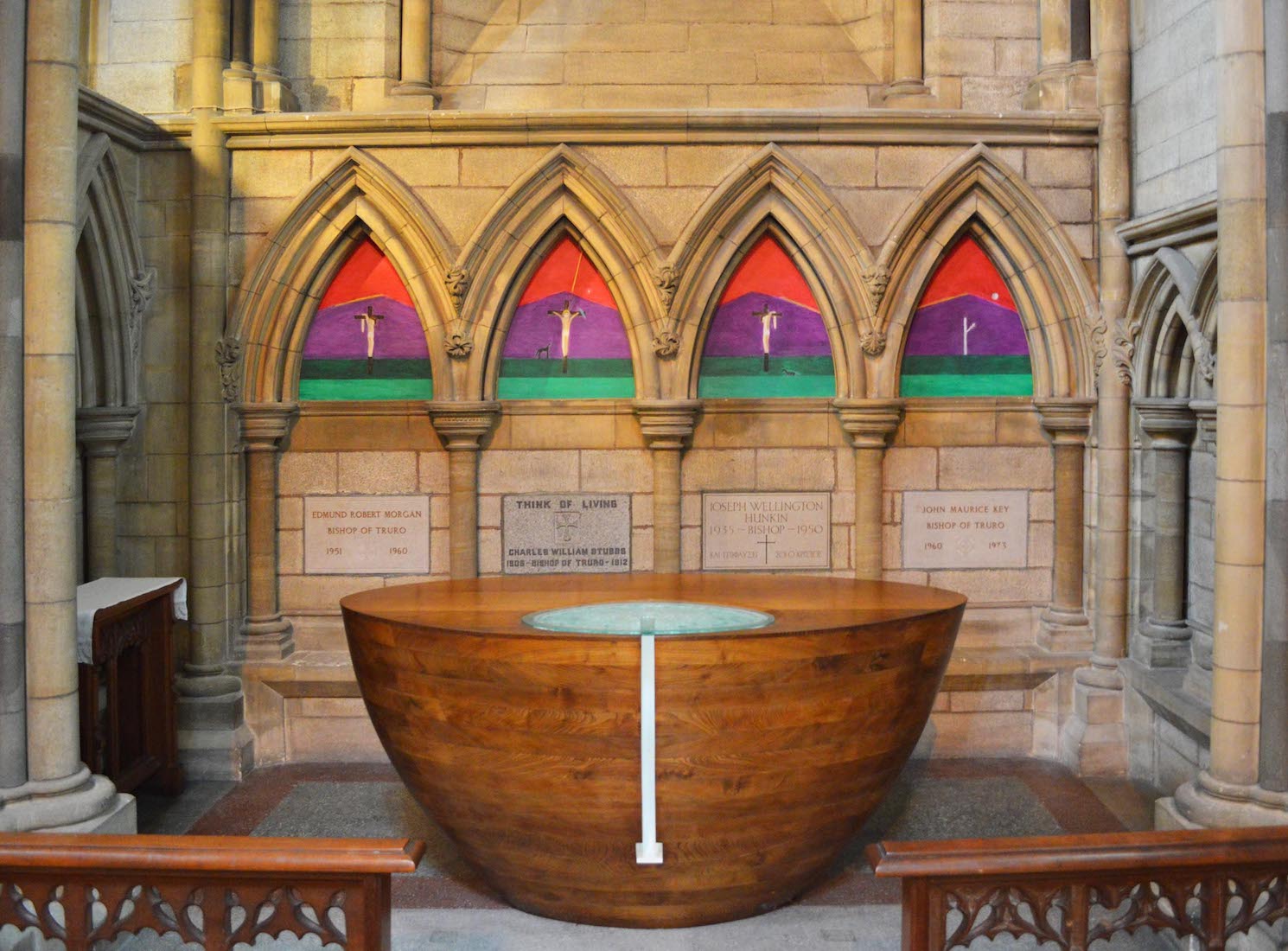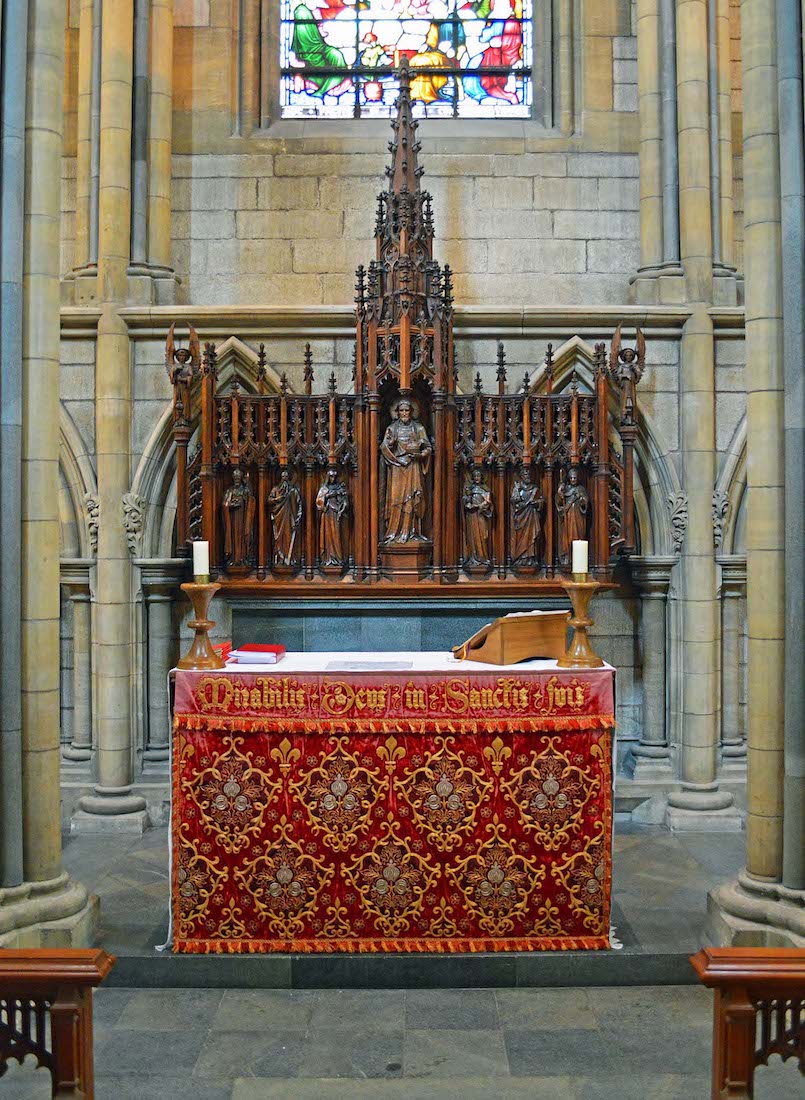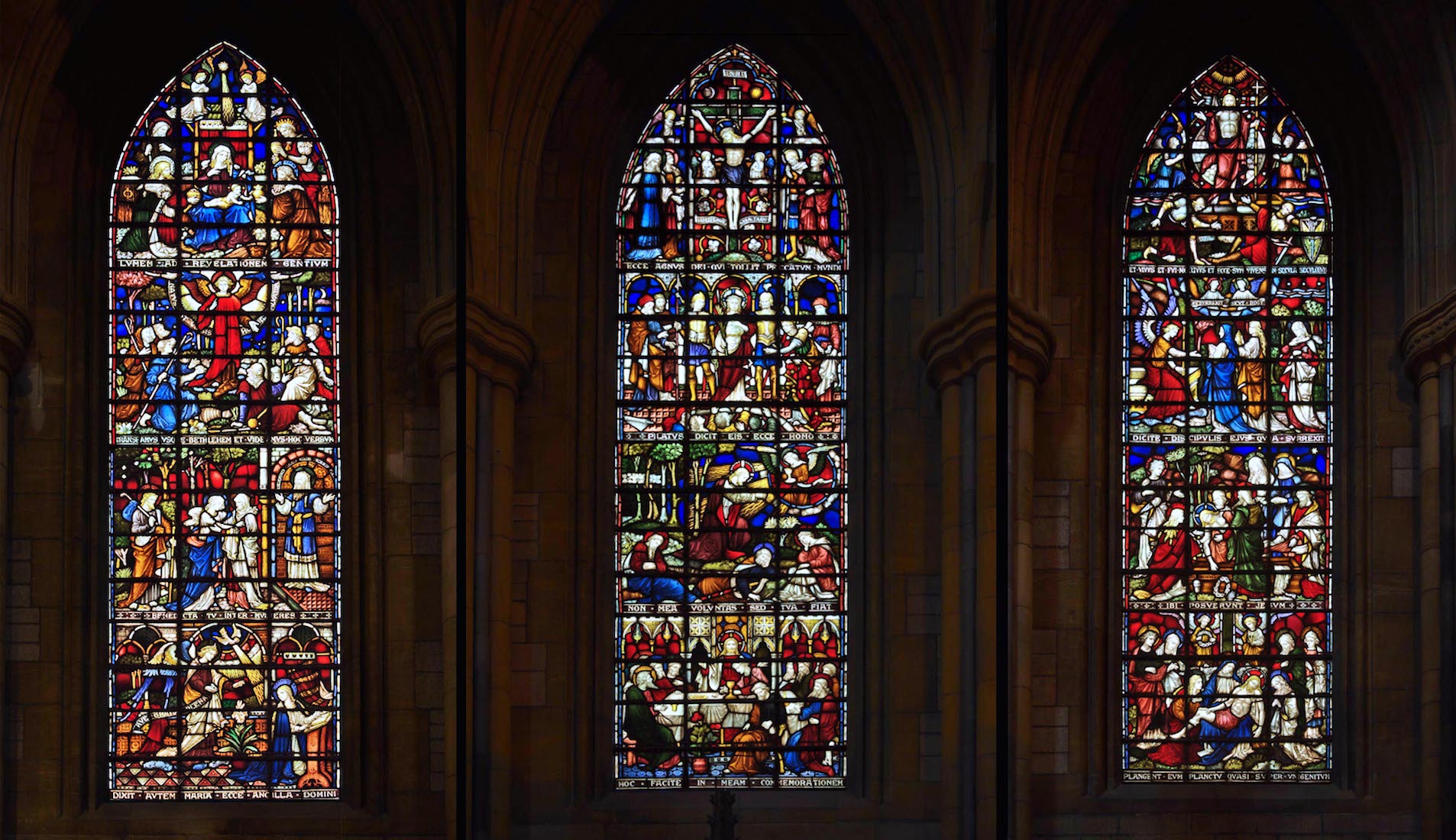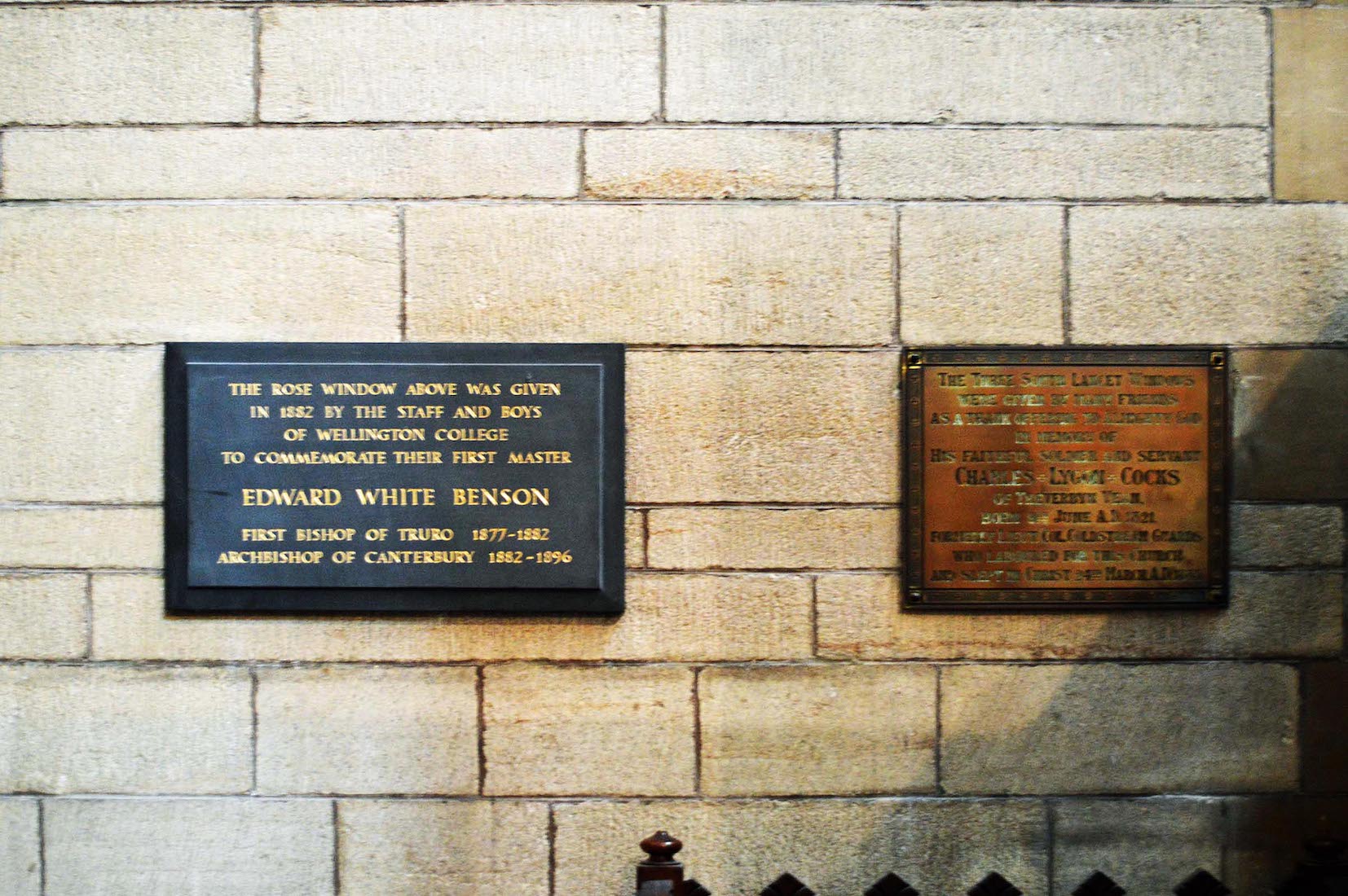
We see that the rose window was given in 1882 by the staff and boys of Wellington College to commemorate their first master, Edward White Benson, First Bishop of Truro (1877 –1882) and Archbishop of Canterbury (1882 – 1896). The more illegible plaque at right tells how the lancet windows were given in memory of Charles Lygon Cox. PLAN
42. SOUTH TRANSEPT: DEANS

The South transept walls also carry these rolls of the Bishops of Truro, and the Deans of Truro Cathedral from 1960. Up until then the Bishop was also Dean of the Cathedral.
43. SOUTH QUIRE AISLE
Leaving the South transept, we turn down the South quire aisle. • Immediately on our left is this icon of the Madonna and Child. The word ‘icon’ (Greek : eikon) simply means image. An icon is not an idol but has been described as ‘a doorway to Paradise’. We do not worship the icon but reverence the person whose name it bears. Icons seek to convey the inner spiritual redeemed real person, rather than the natural imperfect one. They always convey the divine light which transfigures the person from within. There are no shadows in icons caused by an external light source.
44. ST NICHOLAS, ST MARY’S CHAPEL
Close by is the entry to St Mary’s Parish Church – a chapel of the present Cathedral. On the left of the entry is a statue of St Nicholas dating from the 15th century. Nicholas was born during the third century in the village of Patara. His wealthy parents, who raised him to be a devout Christian, died in an epidemic while Nicholas was still young. Obeying Jesus' words to "sell what you own and give the money to the poor," Nicholas used his whole inheritance to assist the needy, the sick, and the suffering. He dedicated his life to serving God and was made Bishop of Myra while still a young man. • As we enter the Chapel, we notice the bell pull on our right. We are at the base of the Green Tower in which there are in fact six bells, previously in St Mary's Parish Church, of which five form a chiming peal.
45. ST MARY’S CHAPEL
The Parish Church of St Mary’s is a delight. Above us is the barrel roof, which is a typical example of Cornish church roof construction. It still contains many of the original 16th century timbers. Near the front at left is an 18th century octagonal pulpit with inlaid scenes. Beyond is the 17th century Byfield Organ which was originally constructed for the Chapel Royal at Westminster, but never installed there. It was presented to the church by a local mine owner, William Lemon. And at centre, above the altar is a hanging pyx by Sir Ninian Comper in which the consecrated bread is kept. Behind the altar is an ornate 3-panelled triptych.
46. CHAPEL BAPTISTRY, COATS OF ARMS
In the context of the Cathedral the central aisle of St Mary’s Church is known as St Mary’s Aisle. At the Western end stands a very old baptismal font. • Near the baptistry is a display of the coats of arms or devices associated with Truro Cathedral and the Parish Church of St Mary.
47. CHAPEL TRIPTYCH
The triptych behind the altar was designed by Frank Pearson, whose father John Loughborough Pearson designed the Cathedral. This triptych shows scenes from the Nativity. A triptych is a work of art (usually a panel painting) that is divided into three sections, or three carved panels which are hinged together and can be folded shut or displayed open. Of course the folded triptych is easy to transport.
48. CHAPEL EAST WINDOW
The glass of the East window of St Mary’s Church shows Jesus with his mother in the centre, the Adoration of the Magi at left, and the Presentation in the Temple at right.
49. CHAPEL: RECTORS, BOSSES
Other items of interest in this old Parish Church are the list of Rectors, and the ceiling bosses. The list of Rectors begins in 1264 with John de Balsal, and the list is unbroken up to 2005 when Christopher G. Hardwick was appointed Cathedral Dean. • The roof of St Mary’s is decorated with colourful bosses and leaf decorations.
50. ST MARY’S CHAPEL WINDOWS
And then there are the St Mary’s Chapel windows! A whole wall of colourful stained glass. Notice too the ‘flames’ on top of the wrought iron fence separating St Mary’s from the South Quire aisle.
CHAPEL WINDOW I
We take time to look more closely at the windows of St Mary’s. We begin with the four lancets at the West (right) end. Across the top we see Jesus and the fishermen, and Jesus healing a woman. In the four panels below, Jesus is baptized by John, Jesus meets the woman at the well, the sower sows the seed, and the harvest is gathered in.
52. CHAPEL WINDOW II
In the next four lancets, at top Jesus speaks to St John who records his words, and Jesus tells Mary not to touch him for he has not yet risen. In the bottom panels we see John leading Mary away from the foot of the Cross, the Annunciation, and two panels of angels with the script: ‘I ascend unto my Father and your Father and to my God and your God’.
53. CHAPEL WINDOW III
The next pair of windows show scenes from the life of Jesus. At left we see Jesus and his disciples ministering to the crowds. At right, Jesus enters Jerusalem on the back of a donkey, depicting the events of Palm Sunday. The inscriptions at the bottom of the windows pose a mystery. They read from the left: In memory of Wilnot, wife of Lewis Charles Daubus Died 1814 aged 44; and, In memory of Lewis Charles Daubus Died 1840 aged 39 ! A wrong date? Or father and son? The inscriptions do show the age of these windows.
54. CHAPEL WINDOWS IV
Here are the remaining Eastern windows of St Mary’s. The previous photographs were taken from the South Quire aisle which at this point runs into the minor South Eastern transept. In retrospect, I could have found a creative alternative for photographing these end windows!
55. QUIRE AISLE, ORGAN STEPS, MODEL
Turning our attention back to the South Quire aisle, we pass this little spiral staircase up to the organ loft, heading towards a model of the Cathedral. • Many cathedrals have a model on display. This model was made by Bill Cheshire, and it is claimed that it contains 42 - 43,000 matchsticks and took 1600 hours to complete! It is a remarkable piece of work.
56. BISHOP’S BRASS, SOUTHEAST TRANSEPT
Nearby in the floor is a brass commemorating Walter Howard Frere, D.D. (1863–1938) who was a co-founder of an Anglican religious order, the Community of the Resurrection and later bishop of Truro (1923–1935). He is actually buried in Mirfield. • Beyond the brass is the little South transept. A dominant feature of this transept is the stained glass window, but unfortunately it is impossible to get a good view of this. The construction of this window is interesting in that the intervening columns are reinforced. Notice too the walkways at the base of the window.
57. ST MARGARET’S CHAPEL WINDOWS
We come next to the little Chapel of St Margaret. This chapel also has a single window to the East. This window pictures St John the Divine. In the main scene, he holds a book in his left hand – probably a reference to St John’s gospel, and in his right a chalice from which a serpent is emerging. Below are scenes of him leading Mary away from the Cross, and as an old man, teaching at Ephesus. • The chapel has a double lancet window to the South. The left lancet depicts St James the Greater, St Peter, and St Mark, with Peter receiving the Keys to the Kingdom at the bottom. The lancet at right shows St Matthew, St James the Lesser, and St Thomas. Again there is a scene at the bottom of this window, showing Saints James the Less, Peter and John as leaders of the Jerusalem Church receiving St Paul and St Barnabas.
58. CHAPEL ALTAR
St Margaret’s Chapel, dedicated in 2003, is a blend of modern contemporary art with the older Gothic architecture. The four paintings behind the altar are by Craigie Atchison, a Scottish painter and Royal Academician. The three panels to the left show Christ on the Cross with the two thieves, one on either side. The altar is constructed from fumed chestnut, and has a boat shape suggesting an ark. Light from above passes through the glass panel on top of the altar, and is focussed outwards through the vertical strip to the worshipper.
59. ALL SAINTS’ CHAPEL
There is a North – South retroquire aisle running across the East end of the Cathedral, and three chapels face onto it. The central chapel is the All Saints’ Chapel. All Saints’ Day (1st November) is a principal feast in the Church calendar. It celebrates and honours all the saints, known and unknown, whose lives have given inspiration to others. The oak reredos has some very fine carvings.
60. LOWER EAST WINDOWS
Up above the altar of the All Saints’ Chapel are these fine windows depicting scenes from the life of Christ. These windows sit just below the great East windows which we shall view later.


